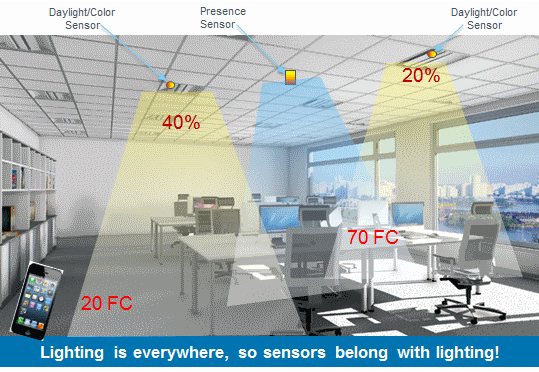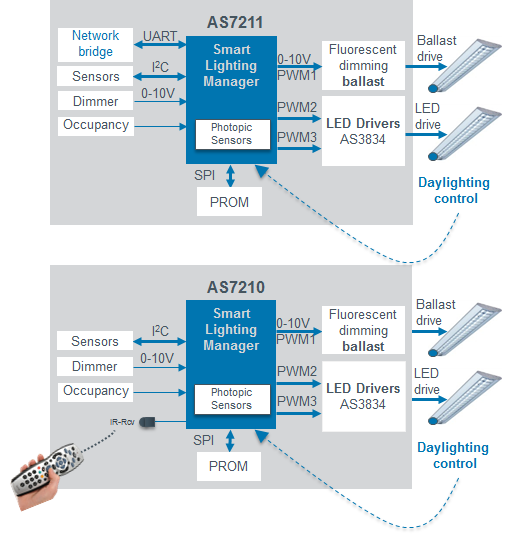The recent introduction of the ams AS721x family of smart lighting silicon photonics sensor ICs was a breakthrough in smart building lighting that the company touts a new paradigm connecting the IoT with new applications. Essentially, what they’ve done is integrate sensors, a smart lighting manager, and wireless connectivity to the Internet. The concept then goes further by adding sensor networks in the ceilings and walls to gather information on presence/occupancy, temperature/humidity, carbon monoxide/dioxide, and fire/smoke. The building maintenance personnel can then monitor and respond to this data via a smartphone. As indicated on the graphic it can use sensors to detect the amount of sunlight in a room and lower or raise the lighting level and the color level of the lighting nearest the window versus farthest away, to keep the lumens and correlated color temperature constant throughout the room.

How does it do that?
The smart lighting manager adapts lighting levels based on daylight by keeping the lumen output at a targeted output with 1 to 100% dimming. It also can provide automatic lumen maintenance and can adjust lumen output from lamp to lamp to keep it constant throughout a system. The chip features pin out for fluorescent dimming ballast and LED drivers allowing you to mix and match. The AS7211 offers a UART bridge for network clients including Bluetooth, ZigBee, WiFi, and Ethernet, and all that in chip-scale package measuring 2.3 x 2.1-mm.

Block diagram of the AS721x autonomous daylighting manager
What it means
Smart lighting is big and will get much bigger. It therefore is not too far a stretch to observe that integrated sensor controls are important for lighting, and will become the norm. This ams product is a glimpse of the future because it is the first to integrate sensors into the lighting control chip. But what’s really a smart move by the company –it can be used in existing luminaires and lighting controls, and that’s where the volume is. The uptake for this type device should be quick. The existing discrete products on the market can do much of the control but they are discrete devices and require tuning of every piece. This ams device uses an algorithm to make it all work seamlessly.
According to a study by Energy Center of Wisconsin (ECW), the cost for adding this type of centralized daylighting controls can range anywhere from 75 cents to 3 dollars/sq ft. The cost for implementing the AS721x is expected to be
Advertisement





